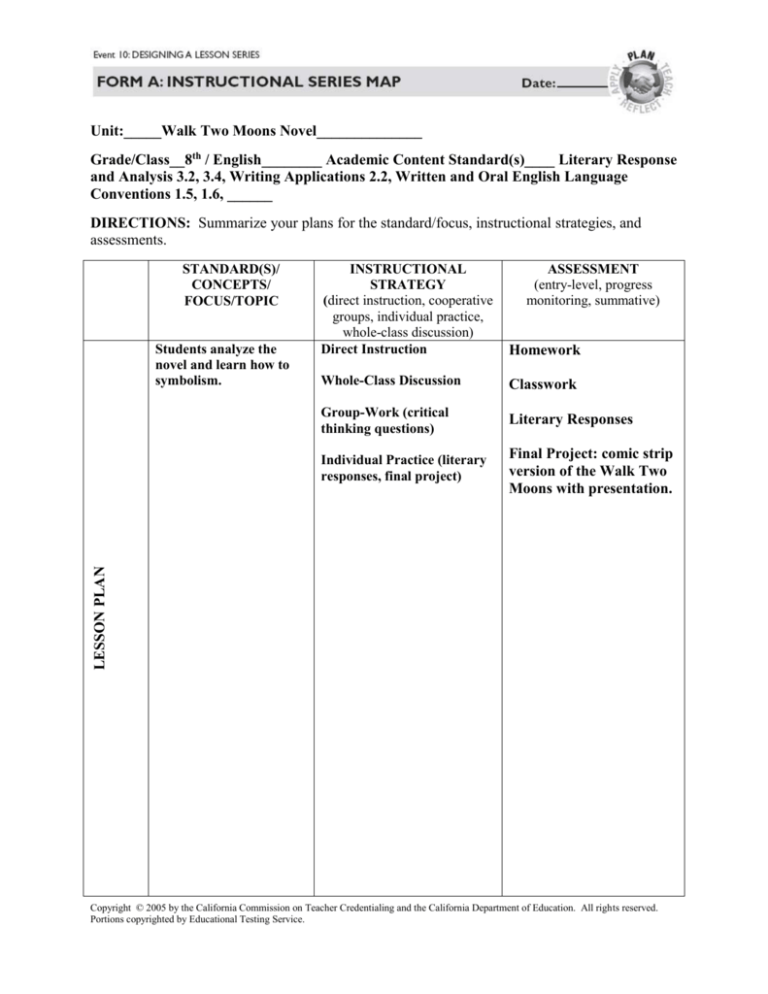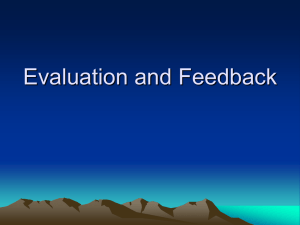
Unit:_____Walk Two Moons Novel______________
Grade/Class__8th / English________ Academic Content Standard(s)____ Literary Response
and Analysis 3.2, 3.4, Writing Applications 2.2, Written and Oral English Language
Conventions 1.5, 1.6, ______
DIRECTIONS: Summarize your plans for the standard/focus, instructional strategies, and
assessments.
STANDARD(S)/
CONCEPTS/
FOCUS/TOPIC
ASSESSMENT
(entry-level, progress
monitoring, summative)
Homework
Whole-Class Discussion
Classwork
Group-Work (critical
thinking questions)
Literary Responses
Individual Practice (literary
responses, final project)
Final Project: comic strip
version of the Walk Two
Moons with presentation.
LESSON PLAN
Students analyze the
novel and learn how to
symbolism.
INSTRUCTIONAL
STRATEGY
(direct instruction, cooperative
groups, individual practice,
whole-class discussion)
Direct Instruction
Copyright © 2005 by the California Commission on Teacher Credentialing and the California Department of Education. All rights reserved.
Portions copyrighted by Educational Testing Service.
DIRECTIONS: Identify the critical understandings and skills for the selected content
standard(s) which you would expect students to have prior to the lesson series you are planning.
Identify prior experiences students may have had with the standard(s).
What prerequisite skills, concepts and knowledge will students need in order to meet the
standard(s)? Information sources include classroom assessment, district assessment, and CAT6
(grades 3,7,10), STAR (grades 2-11), and CELDT.
Class: Basic note-taking skills, critical thinking skills, reading comprehension abilities,
basic drawing skills, and basic writing skills.
English learners: Same as above, but also basic English vocabulary skills.
MODIFICATIONS/ACCOMODATIONS:
English Language Learner:
Student will receive extra handouts helping with analysis on the story prior to starting and
with an optional presentation.
Special Education Student:
Same as English Language Learner.
Resources you might use:
Academic Content Standards/Framework
Teacher Resources – teacher’s guides, other instructional/support materials including Specially Designed Academic
Instruction in English (SDAIE) materials.
Student Resources – student texts, charts, rubrics, activity cards, exemplars, technology applications
District Curriculum Guides/ Course of Study
Observations and discussions with colleagues with subject-matter expertise and//or SDAIE experience and expertise
Copyright © 2005 by the California Commission on Teacher Credentialing and the California Department of Education. All rights reserved.
Portions copyrighted by Educational Testing Service.
DIRECTIONS: Complete one instructional plan for each lesson on Form A. If you use a
district lesson plan, copy and attach.
INSTRUCTION PLAN
K-12 Academic Content Standard(s):
REFLECTION
MODIFICATIONS/ACCOMODATIONS:
English Language Learner:
Same.
What is the academic learning goal(s)?
Students are able to write literary responses
to literature reads in class.
Students are able to create a comic strip
representing a book read in class.
Students are able to answer critical thinking
questions based on a reading.
Special Education Student:
Same.
Copyright © 2005 by the California Commission on Teacher Credentialing and the California Department of Education. All rights reserved.
Portions copyrighted by Educational Testing Service.
INSTRUCTION PLAN
What instructional strategies and activities
will you use for this lesson?
Class: Variety of activities is helpful to
create a good learning environment.
Creating a comic strip allows the students to
use their creative side, while at the same
time applying their acquired knowledge.
Literary responses, critical thinking
questions, and the final project offer
students many outlets to show their skills.
English Language Learner modifications:
Student will receive extra handouts prior to
the reading of the novel about the book,
receive the comic strip assignment earlier,
and have an optional project presentation.
REFLECTION
In what ways are your instructional strategies
and activities effective in measuring the
learning goals for this lesson?
Class:
The comic strip shows the students ability to
represent the story with as little words as
possible, and using more images. That will
show their ultimate understanding, which is
also shown in their literary responses and
critical thinking questions.
English Language Learner:
The extra time getting familiar with the
book will allow them to feel comfortable
with the novel and doing the final project.
Special Education Student:
Same as English Language Learner.
Special Education Student modifications:
Same as English Language Learner.
Copyright © 2005 by the California Commission on Teacher Credentialing and the California Department of Education. All rights reserved.
Portions copyrighted by Educational Testing Service.
INSTRUCTIONAL PLAN
PROGRESS MONITORING ASSESSMENT
What evidence (student work) will you collect
during this lesson that will show the extent to
which students have achieved the learning
goal(s)?
Class:
Homework, classwork, literary responses,
and final comic strip project.
English Language Learner modifications:
Same.
REFLECTION
In what ways are your assessment strategies
effective in measuring the learning goals for
this lesson?
Class:
All the work collected are based on the
learning goals and also shows the students
mastery of skills. It allows the students to
show their knowledge in different outlets
and receive constant feedback along the
way.
English Language Learner:
Same.
Special Education Student:
Same.
How might you modify assessment of the
academic content standard(s)?
Special Education Student modifications:
Same.
Class:
Academic Content Standards are
considered prior to creating the unit and
lesson plans.
English Language Learner:
Same.
Special Education Student:
Same.
Copyright © 2005 by the California Commission on Teacher Credentialing and the California Department of Education. All rights reserved.
Portions copyrighted by Educational Testing Service.
INSTRUCTIONAL PLAN
How will you group students for instruction
during this lesson? (based on reading level,
English learner level, etc.)?
Students will be able to chose their own
groups.
REFLECTION
In what ways are these grouping(s) appropriate
for your students?
Class:
It is later in the school year so the students
can chose groups they are comfortable with,
plus their group work is not lengthy.
How did you choose the group for English
Language Learner?
Students will be able to chose their own
groups (it’s later in the semester so it is
whoever they feel comfortable with)
English Language Learner:
Same.
How did you choose the group for Special
Education Student?
Same.
Special Education Student:
Same.
What instructional materials and technology
will you use?
Walk Two Moons novel, paper, pen, pencil,
coloring material, and textbook.
In what ways are the materials and technology
effective?
Class:
All materials available through the school,
which makes easy accessibility.
English Language Learner modifications:
Extra handouts on the novel.
English Language Learner:
Same.
Special Education Student modifications:
Same as English Language Learner.
Special Education Student:
Same.
Copyright © 2005 by the California Commission on Teacher Credentialing and the California Department of Education. All rights reserved.
Portions copyrighted by Educational Testing Service.









